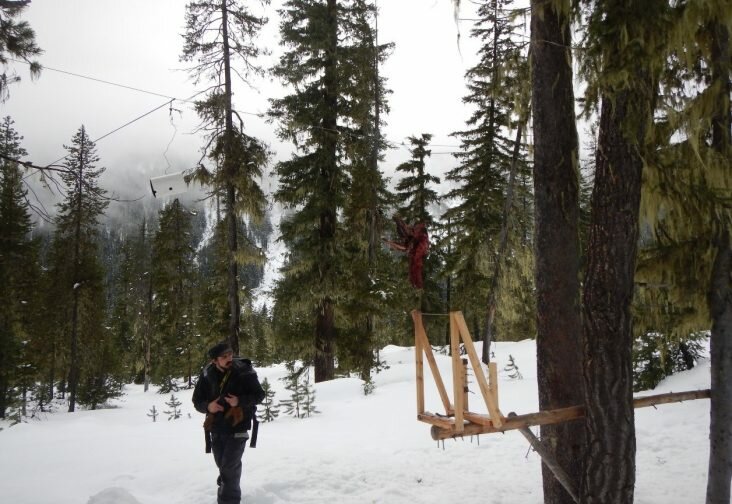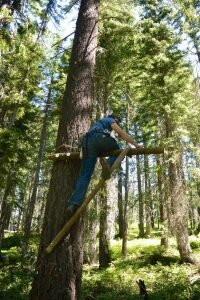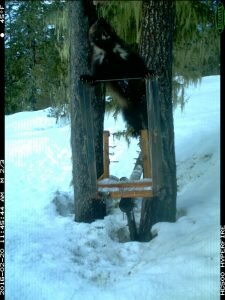Searching for wolverines in the I-90 corridor

Aja Woodrow, U.S. Forest Service (USFS) Wildlife Biologist, has a clear goal: to document the abundance and distribution of wolverines in proximity to Interstate 90 around Snoqualmie Pass—as part of an ongoing, collaborative effort between USFS and Washington State Department of Transportation (WSDOT). However, acquiring these results is not such an easy task, as his species of interest is ever so elusive in the Pacific Northwest. Even the most seasoned PNW hiker, climber, skier, or mountaineer could consider themselves lucky to so much as stumble upon the tracks of this charming creature. With that in mind, having the opportunity to interview Woodrow on his work with wolverines was especially exciting.
As in a similar case for many other Washington species, wolverine habitat is currently divided between north and south in the Cascades by Interstate 90. Recent studies have shown that wolverines are occupying and utilizing the North Cascades, but not a very significant portion of suitable habitat south of the interstate. This disconnect for wildlife is one of the central issues that the construction of wildlife crossings on I-90 aims to address, by providing a habitat pathway between populations and individuals on either side of the highway.
Woodrow has been studying wolverines since 2013, when he began working on the North Cascades Wolverine Study out of Winthrop, WA. He’s continued this effort through today extending the methodologies from that study to his work in the I-90 corridor.
The study methods Woodrow and his colleagues use are finely orchestrated but ultimately quite simple. A run-pole setup, is best represented in photo form (see images above and to the right), but does require some explanation to fully grasp its purpose. The run-pole procedure involves: locating a suitable tree in perceived wolverine habitat, climbing up the tree to build a “walk the plank” type of wooden structure, and rigging a piece of bait to tempt a wolverine near the end of the walkway. The idea of the run-pole is that the bait, which is actually roadkill collected from I-90 (a good way to make use of unfortunate collisions), will attract the wolverine out to a point of view where the researchers can capture a clear look at the white coloration and pattern on the animal’s chest. Each wolverine displays this white patch of chest fur in a unique way similar to the design of a human’s fingerprint, making it a common identification attribute for distinguishing between and recording different individuals.
More intensive studies including over a longer period of time are needed to understand trends in wolverine abundance and distribution in the I-90 corridor, but Woodrow’s efforts to date have demonstrated that they are present. His run-pole stations and credible sightings tell us they are in relatively close proximity to I-90 including in the Teanaway area just north of Cle Elum. The closest sighting to I-90 to date was last winter at the top of Box Canyon, which is just 7-9 air miles from the interstate. This was also the first confirmed female sighting in the area—an exciting discovery since up until then they had only documented, and confirmed the gender of, males.
Other than its obvious qualities of being a fearless, adorable, and generally awe-inspiring creature, the wolverine provides many reasons for which we should be looking out for its population. Woodrow says that wolverines are especially important because they serve as an indicator species for ecosystem health. Meaning, if we can manage to sustain this species, we will then expect to be able to maintain many other, lower-in-the-food-chain species as well. Because wolverines will eat just about anything that is dead or seems realistic to take on, their presence and abundance tends to be a good barometer for other forest carnivores. Additionally, wolverines have a strong preference for living in areas with deep and persistent snow pack, which climate change predictions show decreasing in portions of the Cascades.
The I-90 corridor is important both socially and ecologically to our region, and the 15-mile I-90 Snoqualmie Pass East Project aims to improve the current situation for human and wild populations. For Woodrow, “The fact that we are making it permeable for wildlife makes it that much more special of a spot.” As the project is completed, Woodrow hopes to document in the years to come the interaction between wolverines in the north and south Cascades, and overall, a resurgence of the species throughout the state. In the nearer term, he hopes to build upon their work to date by fitting one or more individual wolverines using habitat near I-90 with GPS collars to help us understand how they are moving on the landscape including near the highway.
Article written by Summer Cook




Ron lowatchie
This is great news , I heard about it before , been watching for tracks up around Cooper Lk in winter , I’m a bobcat and pine marten trapper years ago , and about 40 years back had two folks tell me of watching one for 10 minutes on a hillside and another about a bobcat trapper catching one then , in teannaway . And don’t ask me to say who these people were .its just for your info !